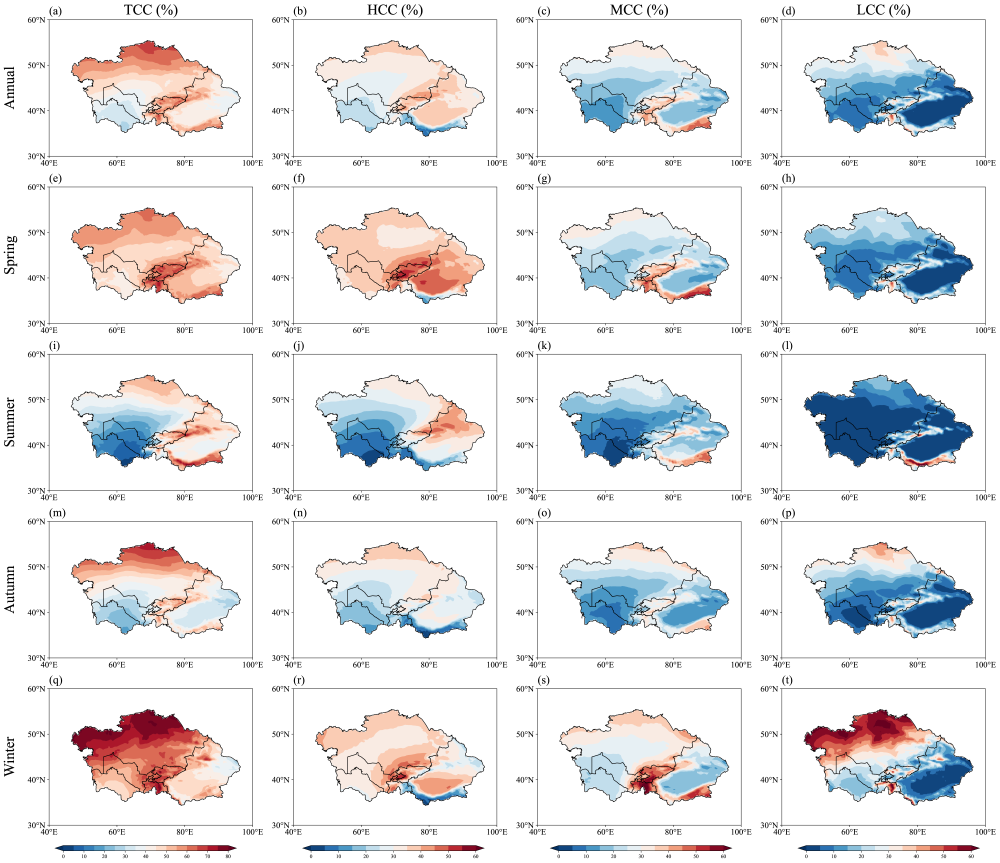
Research Highlight

Clouds are a crucial component of the Earth’s climate system, significantly influencing the radiation balance, hydrological cycle, and regional climate change through their spatiotemporal distribution. Cloud formation and evolution are influenced by factors such as topography, atmospheric circulation, and seasonal variability. In Asia, the diverse geographical landscape—including high mountain ranges, extensive plateaus, and low-lying plains—results in significant spatial heterogeneity in cloud cover patterns. The Institute of Desert Research’s Central Asian Climate and Cloud-Precipitation Physics Research Team, based on ERA5, the International Satellite Cloud Climatology Project (ISCCP), Clouds and the Earth’s Radiant Energy System (CERES), and the Global Precipitation Climatology Centre (GPCC), has revealed the spatiotemporal characteristics of cloud macro- and microphysical properties in Central Asia and their impacts on the regional climate. The cloud cover increases from the southwest to the northeast, with mid and low-level clouds predominating in high-altitude regions. All clouds have shown a declining trend during 1981-2020. According to satellite data, the sharpest decline in total cloud cover occurs in summer, while reanalysis data show a more significant reduction in spring. In addition, cloud cover changes influence the local climate through radiative forcing mechanisms. Specifically, the weakening of shortwave reflective cooling and the enhancement of longwave heating of clouds collectively exacerbate surface warming. Meanwhile, precipitation is positively correlated with cloud cover, and its spatial distribution aligns with the cloud water path. The cloud phase composition in Central Asia is dominated by liquid water, accounting for over 40%, a microphysical characteristic that further impacts the regional hydrological cycle.

Figure 2. Spatial distribution of the annual and seasonal cloud cover over Central Asia during 2001–2020. (a, e, i, m, q) Total cloud cover (TCC, %); (b, f, j, n, r) high cloud cover (HCC, %); (c, g, k, o, s) middle cloud cover (MCC, %); and (d, h, l, p, t) low cloud cover (LCC, %). Seasons are defined as spring (MAM), summer (JJA), autumn (SON), and winter (DJF).
The related research results were published in Remote Sensing under the title “Spatiotemporal Variability of Cloud Parameters and Their Climatic Impacts over Central Asia Based on Multi-source Satellite and ERA5 Data”, with Xinrui Xie, a research intern at the Desert Research Institute, as the first author. This research was funded by Key R&D Program of Xinjiang Uygur Autonomous Region (Grant No. 2023B03019-2), Shanghai Cooperation Organization (SCO) Science and Technology Partnership and International S&T Cooperation Program (Grant No. 2023E01022), China Desert Meteorological Science Research Foundation (Grant No. Sqj2024004), Key R&D Program of Xinjiang Uygur Autonomous Region (Grant No. 2022B03021-1), S&T Development Fund of CAMS (Grant No. 2021KJ034).
Xie, X.; Ma, L.; Yao, J; Mao, W. Spatiotemporal Variability of Cloud Parameters and Their Climatic Impacts over Central Asia Based on Multi-Source Satellite and ERA5Data. Remote Sens. 2025, 17, 2724.
https://doi.org/10.3390/rs17152724

0991-2652429

desert@idm.cn

新疆维吾尔自治区乌鲁木齐市建国路327号


Scan to follow
us on WeChat